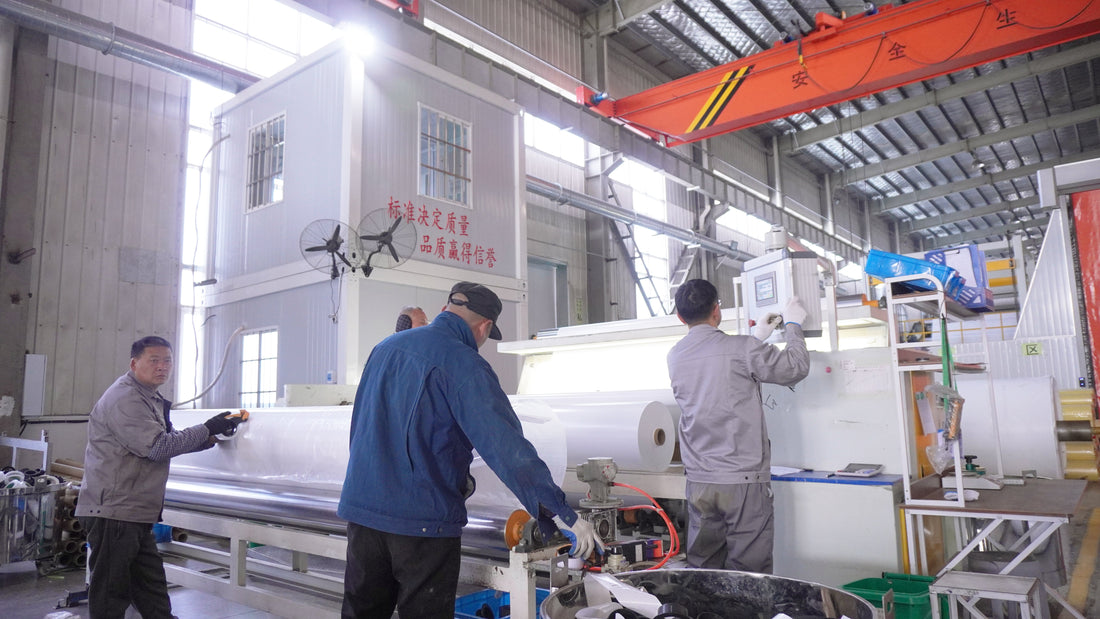
What is PVC Coated Fabric?
Partager
1. Introduction
PVC coated fabric is a high-performance material that combines the durability of synthetic textiles with the protective properties of polyvinyl chloride (PVC). It is widely used across industrial, commercial, and architectural sectors due to its strength, flexibility, and resistance to environmental stresses.
2. What Exactly Is PVC Coated Fabric?
PVC coated fabric is a composite material consisting of a base fabric—typically polyester—coated on one or both sides with PVC. The coating process creates a waterproof, UV-resistant, and durable surface, making it suitable for demanding environments.
Composition Breakdown:
- Base Fabric: Woven polyester (e.g., 500D, 1000D, 1300D)
- Coating Layer: PVC resin + additives (UV stabilizers, flame retardants, anti-fungal agents)
PVC coating is applied through processes like knife coating or calendaring, followed by heat treatment to ensure bonding and uniform surface finish.
3. Key Properties of PVC Coated Fabric
PVC coated fabrics are engineered to perform under stress. Here are their main features:
- Waterproof & Weatherproof
- UV & Heat Resistance
- Fire Retardant (B1/B2/M2 ratings available)
- High Tensile Strength & Tear Resistance
- Flexible in Low Temperatures
- Printable Surface (Solvent, UV, Latex Inks)
- Customizable Colors, Finishes & Embossing
These properties make it an ideal material for both functional and aesthetic applications.
4. Manufacturing Process
The quality of PVC coated fabric depends heavily on both the base textile and the coating technique. Here's how it’s typically made:
- Weaving: High-tenacity polyester yarns are woven into a base fabric.
- Coating: PVC paste is applied using knife coating, ensuring full impregnation and surface coverage.
- Curing: The coated fabric passes through heated rollers or ovens to solidify the surface.
- Finishing: Optional embossing, lacquering (for gloss/matte), or flame-retardant treatment.
At uctextile, vertical integration with in-house weaving and coating allows for tight quality control and product customization.
5. Common Applications of PVC Coated Fabrics
PVC coated fabrics are everywhere—from everyday uses to specialized industrial systems:
• Industrial:
- Truck tarpaulins
- Machine covers
- Oil containment booms
• Commercial:
- Outdoor advertising banners
- Inflatable products
- Temporary structures and tents
• Architectural:
- Tensile membrane roofing
- Stadium canopies
- Shade sails and awnings
• Agriculture & Marine:
- Greenhouse covers
- Fish pond liners
- Boat and dock covers
6. Environmental Considerations
PVC has historically faced criticism for its recyclability and chemical additives. However, manufacturers like uctextile are actively working toward greener solutions:
- Use of low-VOC formulations
- Waste reduction and in-house recycling
- Research into eco-friendlier plasticizers
- Exploring partnerships for closed-loop recycling systems
These efforts align with global sustainability goals while preserving the functionality of PVC coated materials.
7. How to Choose the Right PVC Coated Fabric
Choosing the right fabric depends on the application. Consider:
- Weight (gsm): Heavier for industrial loads, lighter for mobility
- Base Fabric Strength: 1000D or 1300D for high-tensile use
- FR Rating: Required for public safety compliance
- UV and Anti-Fungal Additives: For outdoor or humid conditions
- Color & Finish: Customization for branding or aesthetics
Uctextile offers full customization services, including embossing, logo printing, and anti-slip coatings.
8. Why Choose uctextile?
- As a leading supplier of high-performance PVC coated fabrics, uctextile provides:
- Advanced coating lines
- Fast turnaround with stable supply chain control
- Extensive product testing (UV, tensile, FR, hydrostatic)
- Export-ready documentation and technical support
- Customized solutions for OEM/ODM partners
- Whether for industrial logistics, architecture, or special projects, we deliver fabric engineered for your needs.
Final Thoughts
PVC coated fabric is a cornerstone material for modern industrial and architectural applications. With proper design, sustainable practices, and manufacturing excellence, it remains a smart and future-ready choice. As the global market evolves in 2025, uctextile continues to innovate and lead with quality, service, and technical expertise.
**Interested in learning more or requesting samples? Contact our team at www.uctextile.com
